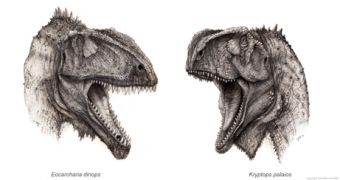These were the masters of Africa 110-million-year ago: two large theropode (carnivore) dinosaurs that grew up to 25 ft (7.6 m) long. The two new species described in the Acta Palaeontologica Polonica journal are Eocarcharia dinops ("fierce-eyed dawn shark"), a predator armed with huge, shark-like teeth, and Kryptops palaios ("old hidden face"), probably a hyena-like scavenger. The new species were found in the Sahara Desert by a team led by Paul Sereno, paleontologist at the University of Chicago and National Geographic Society Explorer-in-Residence.
Kryptops had a short snout, small, sharp teeth, tiny arms, and facial horns.
"From the texture of the [skull] bone it seems like they almost have a bill on the front of their faces for sticking their head in and gnawing away at carcasses. With such a short snout and such puny arms, Kryptops would not be so well designed for grabbing something that was trying to run away," Sereno told National Geographic News.
"Eocarcharia, by contrast, had powerful forelimbs and 3-inch-long (7.6-cm-long) blade-shaped teeth for disabling prey and severing body parts," wrote the authors.
Eocarcharia has a massive brow, inducing a menacing glare, and scientists believe this species and its relatives engaged in head-butting fighting over rights to mate with the females.
"While head-butting between males is usually confined to plant-eating animals, such behavior has been suggested for a few other meat-eating theropods. Meanwhile the idea of a scavenging lifestyle for carnivores such as Kryptops is controversial. If this thing had a fingernail-like covering all over its face, then maybe that was used to poke into carcasses, but I'd like to see more evidence for it," said Matt Lamanna, a dinosaur expert at the Carnegie Museum of Natural History in Pittsburgh, not involved in this study.
The new findings are extremely important in explaining the evolution of the southern theropode dinosaurs during the Cretaceous period (last era of the dinosaurs, 144 to 65 million years ago).
"Kryptops represents one of the earliest known abelisaurids, a group that was also found in South America and India (and Madagascar, too)," wrote the authors.
Eocarcharia belonged to the carcharodontosaurid family that later evolved the largest predatory dinosaurs, like Giganotosaurus, that was larger than Tyrannosaurus rex.
"What we've found are primitive members of the two groups of megacarnivorous dinosaurs that ruled the southern continents for 50 million years. For those of us [who] work on dinosaur evolution, finding these very old and primitive species is kind of like a paleoanthropologist finding a Neanderthal," co-author Stephen Brusatte of the University of Bristol in the United Kingdom told National Geographic News.
"The two new dinosaurs-along with an even bigger predator, the fish-eating, sail-backed Suchomimus-represent a trio of meat-eating lineages that became dominant in Africa and possibly other southern landmasses. For some 20 to 25 million years, these would have been the three big ones you'd have had to watch out for if you'd gone down there," said Sereno. These predators could have preyed on Nigersaurus, a sauropod dinosaur with a muzzle like a vacuum cleaner.
"Around this time Africa was breaking free of Gondwana, the huge southern supercontinent that also included South America," wrote the authors.
"Kryptops shows that abelisaurid origins may have predated the separation of most major Gondwanan continents. While abelisaurids are known from most former Gondwanan landmasses (like South America, India, Madagascar, now Africa), it isn't known whether different geographical groups evolved while the supercontinent was still joined," Lamanna added.

 14 DAY TRIAL //
14 DAY TRIAL //